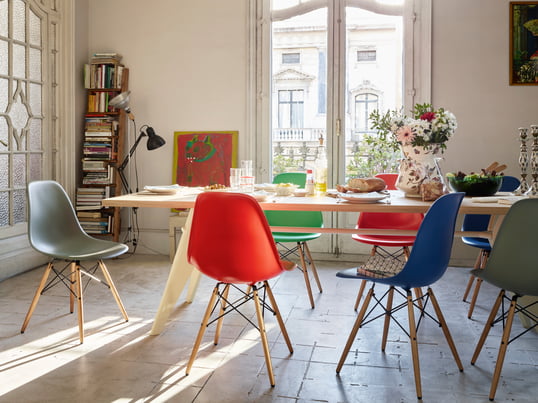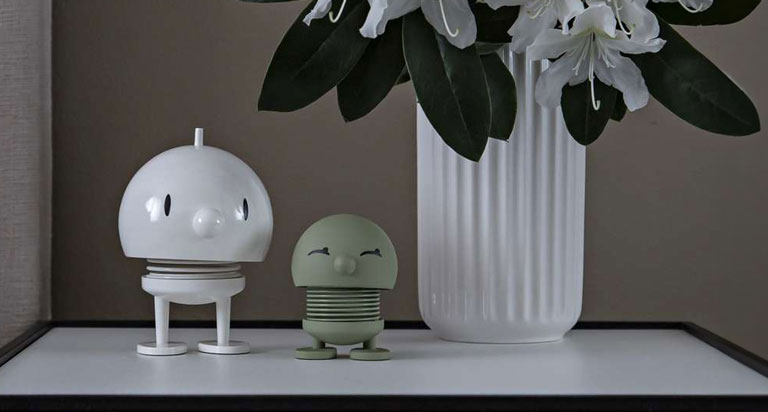The wall and the moon landing, Beatlemania and miniskirts, student protests and Woodstock - the 1960s was a decade of unprecedented change. Political, social, cultural and aesthetic upheavals left noone unaffected. The 60s left their tracks in design, too - creating fresh ways of thinking and releasing unbelievable creativity. To put it another way, 60s design definitively established itself as a force that moved all strata of society, influenced their buying decisions and found a natural, identity-determining place in everyday society.
- Young Design without Limits
- 60s Design – Furniture for the Masses
- 60s Furniture: Space Age – with round Shapes into the Future
- The Late 60s – Rebellion and Politicization
- The Anti Design Movement
- Retro Design for the Flower Power Generation
- Popular Designs of the 1960s
Young Design without Limits
While the solid, unemotional, functional design of the 50s was defined by the two world wars, the 60s looked forward to the future. Instead of 'no experimenting', the motto in the design world was now 'everything is possible'. This optimism was driven by technological progress, economic recovery and a young, well-paid generation that longed not only for emotional, but also visual sensuality.
Imaginative forms, bright colors and new materials in interior design were in demand, as were alternative lifestyles, hallucinogenic substances and pop music. Essentially, going against the establishment and its traditional taste was paramount. People started to reject the structured tailoring of the fashion industry, and values such as stability and functionality no longer had a primary role to play.
The Pop Art movement was not alone in its desire for a new aesthetic that was deliberately ephemeral, mass-produced, humorous and ironic. The lightweight, flexible 60s like the Sacco Beanbag by Zanotta reflected the youth’s fascination with mobility and light heartedness.
60s Design – Furniture for the Masses
The new synthetics made it possible to mass produce cheap products. People no longer bought furniture for the rest of their lives, but started following current fashions that designers gladly provided.
The result was a real design boom, from which the Italian design manufacturers mostly benefited. Designers like Ettore Sottsass, Joe Colombo and Anna Castelli Ferrieri designed brightly colored everyday objects made from ABS plastic for Kartell, Danese and Artemide, whose shapes corresponded to the latest state of technology.
Inspired by the possibilities of the new synthetics, Verner Panton created the Panton Chair, one of the most famous designs of the 60s. The faith in the new synthetics remained unbroken as it was further emphasized in the space age look.
60s Furniture: Space Age – with round Shapes into the Future
The race for the conquest of space had a great impact on people in the mid-sixties and thus also on fashion and design. The question of how one wanted to live in the future, brought forth futuristic designs and manifested itself in the first half of the 1960s through geometric shapes. Movies like Barbarella with Jane Fonda and Stanley Kubrick's 2001 - Space Odyssey showed fantastic white and silver space worlds with softly rounded plastic furniture.
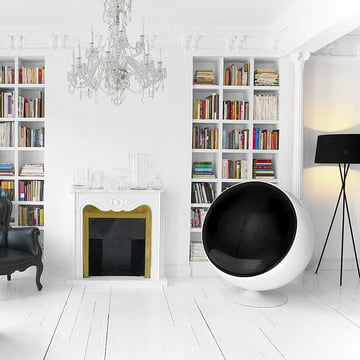
The Ball Chair by Eero Aarnio, the Eclisse Table Lamp by Vico Magistretti and spherical radios or televisions brought the Space Age into the terrestrial living rooms.
The Late 60s – Rebellion and Politicization
As Neil Armstrong set foot on the moon in 1969, the attention of the youth had already moved on to other topics. Students worldwide were taking measures against outdated power systems and the blatant materialism of consumers was seen critical. Technological progress not only brought forth enthusiasm, but also concerns as the Cold War fueled fears of a nuclear disaster. In design, this development was expressed with a neo-organic, psychedelic style, which replaced the geometric shapes.
The Anti Design Movement
With his Visiona II Fantasy Lanscape, Verner Panton created a space, which broke down the traditional conventions and the geometry of the floor, ceiling and walls. Warm, soft, amorphous and colorful, the modules could be changed, so as always to create new perspectives. From Italy came further momentum. Once again, the Anti-Design movement with Ettore Sottsass at their head turned against the impersonal industrially manufactured, materialistic consumer products, which had dominated the first half of the decade.
The claim was now that design objects provoke the intellect and should challenge the perception of the users. In prototypes and manifestos, the Italian designer explored the cultural potential of design and presented kitsch, irony and wrong proportions as a reaction against perfectionist aesthetics of modernism. These characteristics would later become the trademark of postmodern design and influence the Memphis movement.
Retro Design for the Flower Power Generation
As a further response to the lavish lifestyle previously celebrated, the environmental movement arose in the late 60s, advocating environmental sustainability through the Club of Rome’s book "The limits of growth". This was accompanied by a renaissance as people returned to the crafts, studio glass, ceramics, and hand-woven rugs. The oil crisis of the early 1970s did the rest for a revaluation of plastic.
From the consumer revolution at the beginning of the decade to environmental awareness, Flowerpower and anti-design - the design world in the 60's took various forms and standpoints. In retrospect, it can be said with certainty that the 60s was the era that put an end to the grey post-war period.
Experience a revival of the 1960s with our classic 60s designs down below.
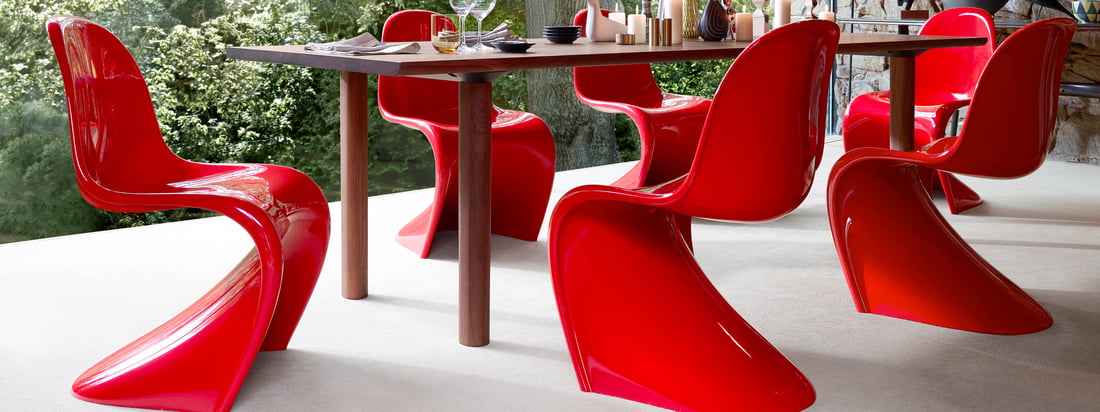
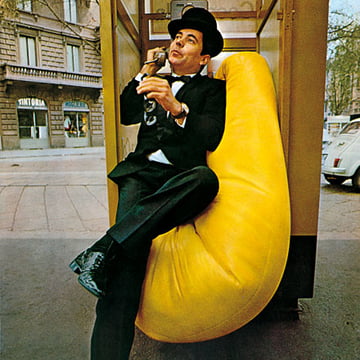
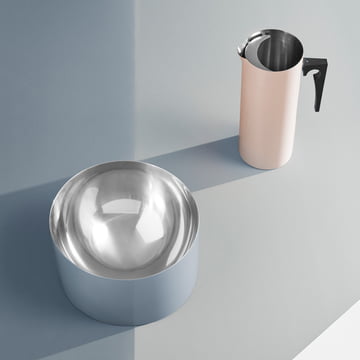
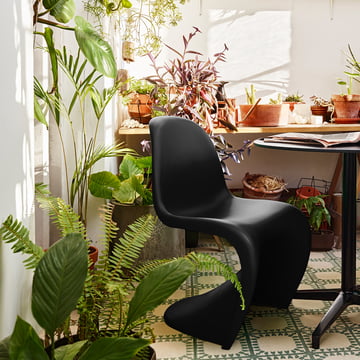
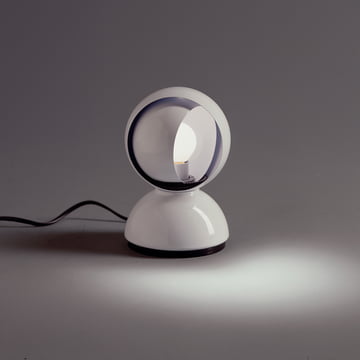
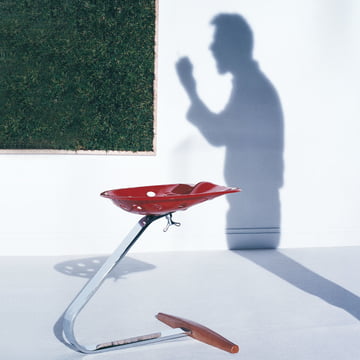
 Fritz Hansen
Fritz Hansen
 Ingo Maurer
Ingo Maurer
 Knoll International
Knoll International
 & Tradition
& Tradition
 Artemide
Artemide
 Danese Milano
Danese Milano
 Flos
Flos
 Kartell
Kartell
 Müller Small Living
Müller Small Living
 Oluce
Oluce
 Stelton
Stelton
 Vitra
Vitra
 Zanotta
Zanotta
 Achille Castiglioni
Achille Castiglioni
 Anna Castelli Ferrieri
Anna Castelli Ferrieri
 Arne Jacobsen
Arne Jacobsen
 Bruno Munari
Bruno Munari
 Eero Aarnio
Eero Aarnio
 Enzo Mari
Enzo Mari
 Gatti, Paolini, Teodoro
Gatti, Paolini, Teodoro
 Joe Colombo
Joe Colombo
 Richard Sapper
Richard Sapper
 Rolf Heide
Rolf Heide
 Verner Panton
Verner Panton
 Vico Magistretti
Vico Magistretti
 Warren Platner
Warren Platner
